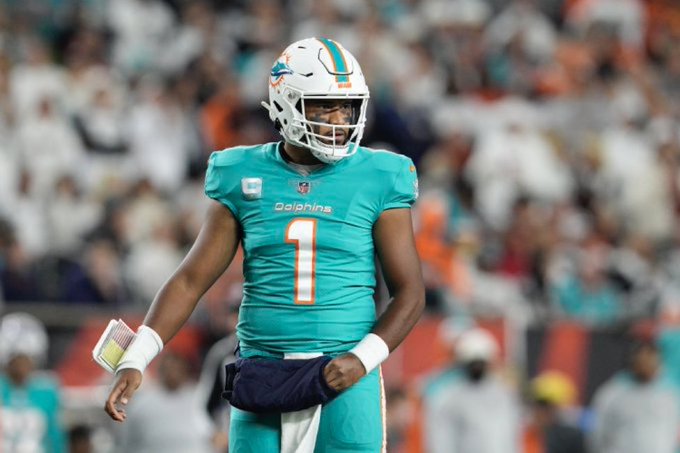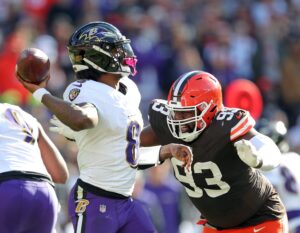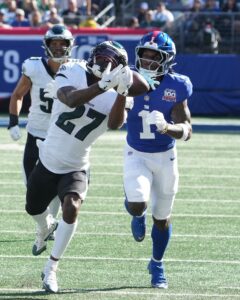Tua Tagovailoa suffered a potential Second Impact Syndrome injury on Thursday Night Football. Cincinnati Bengals defensive lineman Josh Tupou broke through the Miami Dolphins line and flung Tagovailoa to the ground. The young quarterback appeared to his head on the turf and immediately started showing signs of head injury. This is a very dangerous situation as Tagovailoa appeared to have a similar injury last Sunday against the Buffalo Bills.
Scary Potential Sudden Impact Injury for Tua Tagovailoa
Possible Concussion Last Sunday
Last Sunday, Tagovailoa went down hard, hitting his head on the turf against the Buffalo Bills. The young quarterback then appeared to stumble several times before requiring help to get to the locker room. Much to everyone’s surprise, Tagovailoa returned to the game as the Miami Dolphins reported the injury was related to his back, not his head. The Former Crimson Tide signal-caller was absolutely showing outward and observable signs and symptoms of head injury.
The Dolphins organization is under fire from the NFLPA regarding the handling of Tagovailoa’s potential head injury. The NFLPA reportedly is launching an independent investigation of the quarterback’s treatment and the decision-making process to hold him out of concussion protocol. The NFL’s concussion protocol and testing have become much more strict over the past few seasons with independent doctors after the emergence of CTE (Chronic Traumatic Encephalopathy).
Another Possible Concussion on Thursday Night Football
This situation on Thursday Night Football is dangerous because of Second Impact Syndrome (SIS). SIS occurs when an individual suffers a brain injury, often a concussion. The individual then suffers a second injury before the brain has had time to fully heal from the first impact. After an individual has a concussion the brain engages protective measures to promote healing. These protective measures make the brain much more vulnerable “to death after a sub-lethal insult of even less intensity,” (Second Impact Syndrome). The potential consequences of SIS include increased intracranial pressure and even brain herniation resulting in death.
Tagovailoa obviously suffered a head injury on Thursday Night as evidenced by his loss of consciousness and the gruesome decorticate posturing. Decorticate posturing occurs after a brain injury and presents with the extremities bending and the body becoming rigid. We saw this as Tagovailoa laid flat on his back, with his eyes closed, elbows bent, hands in his face, and fingers flexed to a contorted configuration. Other signs and symptoms of concussion include headache, dizziness, fatigue, insomnia, irritability, and difficulty with concentration, memory, and intellectual difficulties.
Tua #GoFins
I have serious concerns about ANOTHER concussion, this time with decorticate posturing.
As I mentioned previously, the main concern if returning from a concussion before symptoms resolve is Second Impact Syndrome.
Let’s hope not because that could be deadly. 🙏🏼 pic.twitter.com/amDKL9XiJL
— Jesse Morse, MD (@DrJesseMorse) September 30, 2022
Clinical Decision-Making Regarding Tagovailoa’s Health
As a physical therapist, I would not have advised him to return to the game last Sunday. His condition obviously exhibited that of a concussed player considering his stumbling and apparent dizziness. It is impossible to know what tests the physicians performed and which signs and symptoms Tagovailoa exhibited during halftime last Sunday. Regardless, the potential for SIS is now a genuine threat as the decorticate posturing was likely the result of brain injury and loss of consciousness.
The Dolphins and Tagovailoa need to prioritize the quarterback’s health above their season. They must ensure he is 100% healthy with an unremarkable CT scan before he returns to action. He will be susceptible for SIS for up to 10 days following the injury. He will also require constant monitoring as the emergence of concussion symptoms can manifest up to four weeks after the initial injury.
Good News
Tagovailoa was quickly taken to the University of Cincinnati Medical Center to undergo further testing. Fortunately, he has already been discharged and has been cleared to travel home with the team. This is good news as an emergency department (ED) physician would likely not discharge him without CT imaging and extensive testing to rule out possible intracranial hemorrhaging or residual concussive effects. The fact that the ED discharged him and is allowing him to fly home is a great sign for his prognosis in recovering from this injury.
Tua Tagovailoa will be released from the hospital and will travel home with the Dolphins, per Amazon broadcast
Great news 🙏 pic.twitter.com/9xGyafeQGv
— PFF (@PFF) September 30, 2022
Possible Consequences
If the Dolphins run Tagovailoa back out to the field prematurely, it could cost them more than a win or loss next Sunday. The quarterback could suffer lifelong cognitive and physical disability and even risks his life. Tagovailoa and his family need to have a discussion and take charge of his health for his own good. They must prioritize football when he is granted a clean bill of health.






